Technologies
PSVR 2 vs. Quest 2: Which Should You Buy, or Should You Wait?
Two very different VR headsets compared — and you may also want to wait for the inevitable Quest 3.
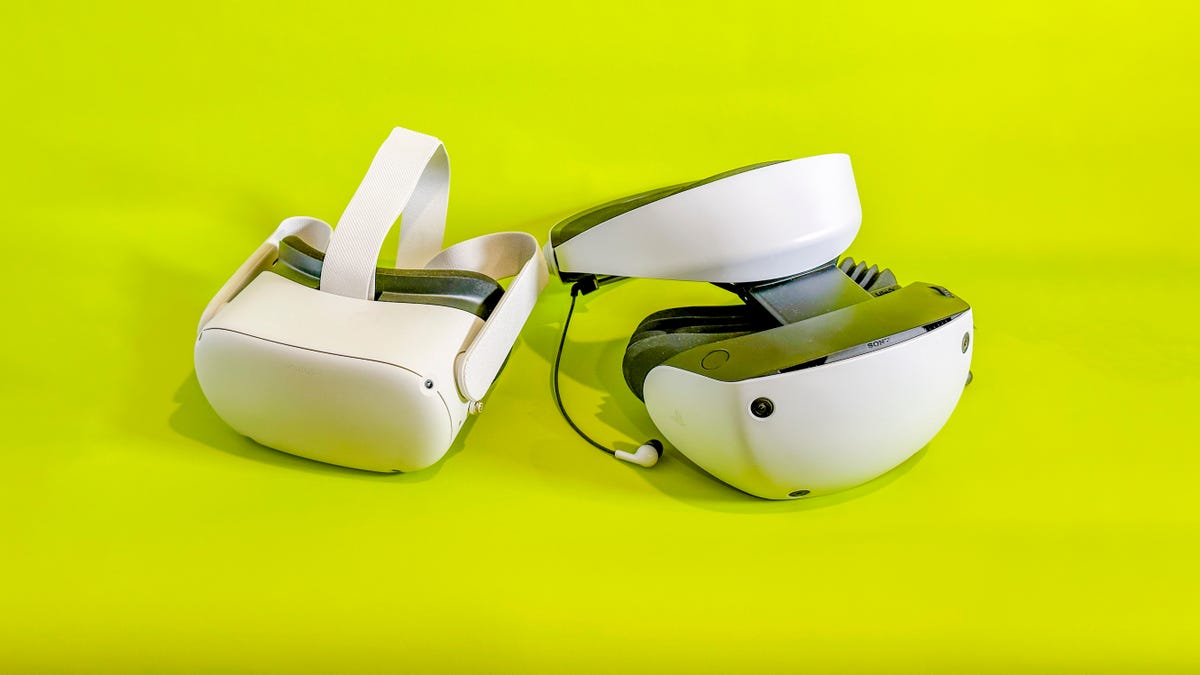
Sony’s PlayStation VR 2 is the PlayStation 5’s first dedicated VR headset, but 2023 is just getting started. With Meta’s Quest 3 expected by the end of the year and Apple’s unknown VR/AR headset expected to make an appearance as well, this isn’t necessarily the best time to get a VR headset. But we love a lot of what the PSVR 2 offers, even if it’s currently limited to a smaller game library and needs a wired connection to a PS5.
The Quest 2 is the most successful VR headset, although it’s over two years old. Here’s how these two devices differ and what each is best at. My colleague Justin Eastzer and I deeply discussed the topic in the video embedded in this story.
For more, read CNET’s PSVR 2 review and Quest 2 review, and check out our favorite Quest 2 games and PSVR 2 games.
Read more: Best VR Headsets of 2023
Hardware: Standalone vs. cabled
The Quest 2 is a fully self-contained VR game system; nothing else is required. For its $399 (£399, AU$630) price, that’s a huge advantage that other competitors are still trying to match.
The $550 (£530, AU$880) PlayStation VR 2, meanwhile, is tethered to a nearly 15-foot cable that needs to be plugged into a PlayStation 5. It doesn’t work on its own at all. It’s really a headset extension of your PS5.
That difference in design makes a bigger impact than you might think. The Quest 2’s portability also means it’s an easy headset to set up for full-motion VR gaming and fitness games and apps. Games like Beat Saber, and fitness apps like Supernatural, are some of the best things you can do on the headset.
The PSVR 2’s cable is long, and it feels heavy. The one-cable setup and its self-contained in-headset camera-based tracking are a lot easier to set up than the original PSVR was, but it’ll still need to live wherever your PS5 lives, and makes the PSVR 2 a better sit-down or stand-in-place experience than a full-motion one.
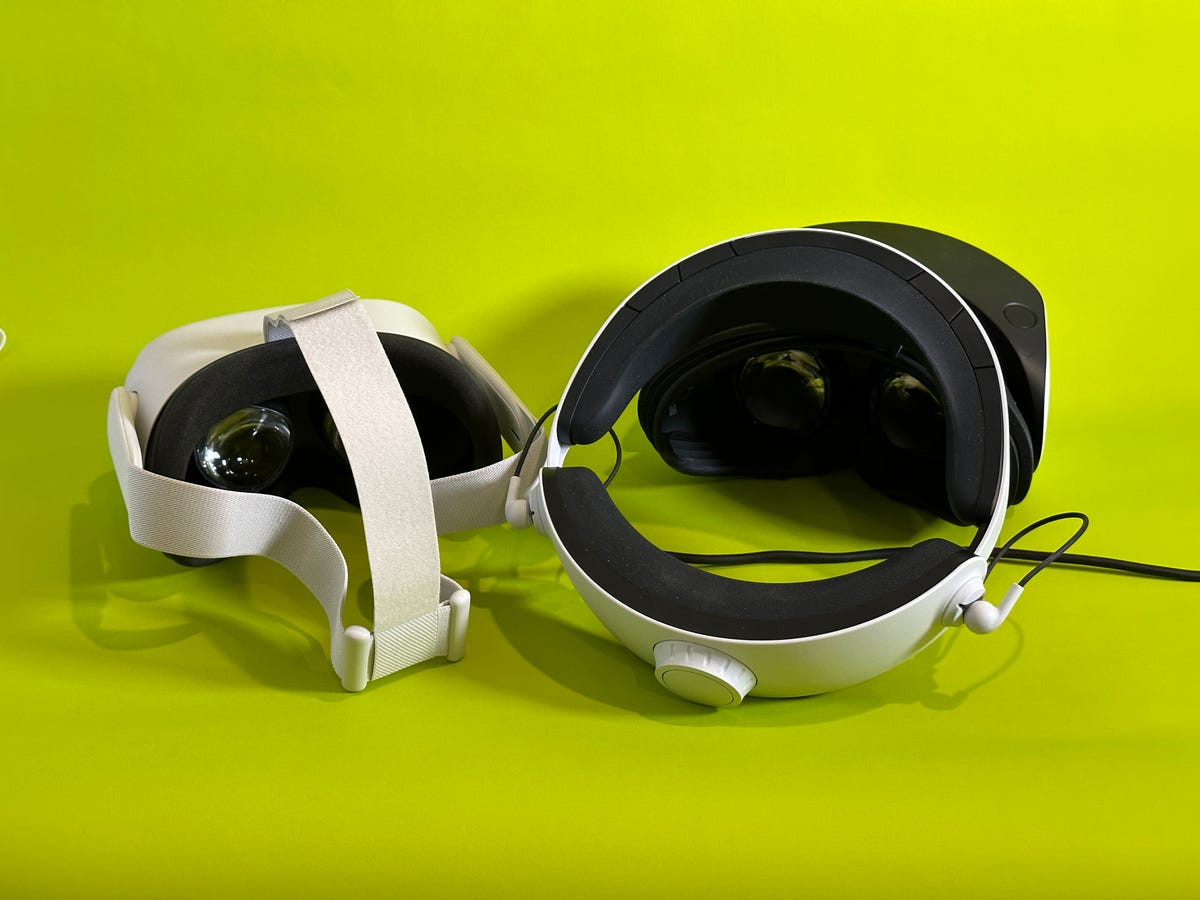
The Quest 2 (left) is more compact, but has less impressive graphics and optics. The PSVR 2 fits my glasses better, is comfier, but it’s bigger.
Scott Stein/CNETDisplays and audio: PSVR 2 has a big edge, mostly
The Quest 2’s LCD-based display is pretty sharp (1,832×1,920 pixels per eye), but the PSVR 2’s 2,000×2,040 pixel-per-eye HDR OLED display is higher res, more vivid and has much better contrast and black levels. Colors are bright and rich. On top of that, the PSVR 2’s ability to drive PS5-quality graphics means games have greater detail than the Quest 2. The latter uses an integrated Snapdragon XR2 mobile processor that’s less powerful, although the Quest 2 can be tethered to a gaming PC, which lets it play higher-end games similarly to the PS5.

The PSVR 2 (right) can adjust its distance from your face, but its visor design is bulkier.
Scott Stein/CNETThe Quest 2 has speakers that pump 3D audio near your ears but still lets other sounds in, which is bad for cinematic experiences but good for hearing kids or alarms — handy when absorbed in VR. It also has a headphone jack. The PSVR 2 has included earbuds for 3D audio but no speakers, which means you’re far more isolated when listening to audio. The earbuds sound OK, but Sony’s wireless Pulse 3D over-ear headphones (sold separately) offer better sound. The PSVR 2 has a headphone jack too, just like the Quest 2.
The PSVR 2 also adds an extra couple of immersive wrinkles. The headset uses eye tracking to boost graphics quality where your eyes are looking via foveated rendering technology. The headset also has rumble, which sounds gimmicky but can feel like an extension of bass vibrations in-game, adding an overlap between sound and immersive sensation.
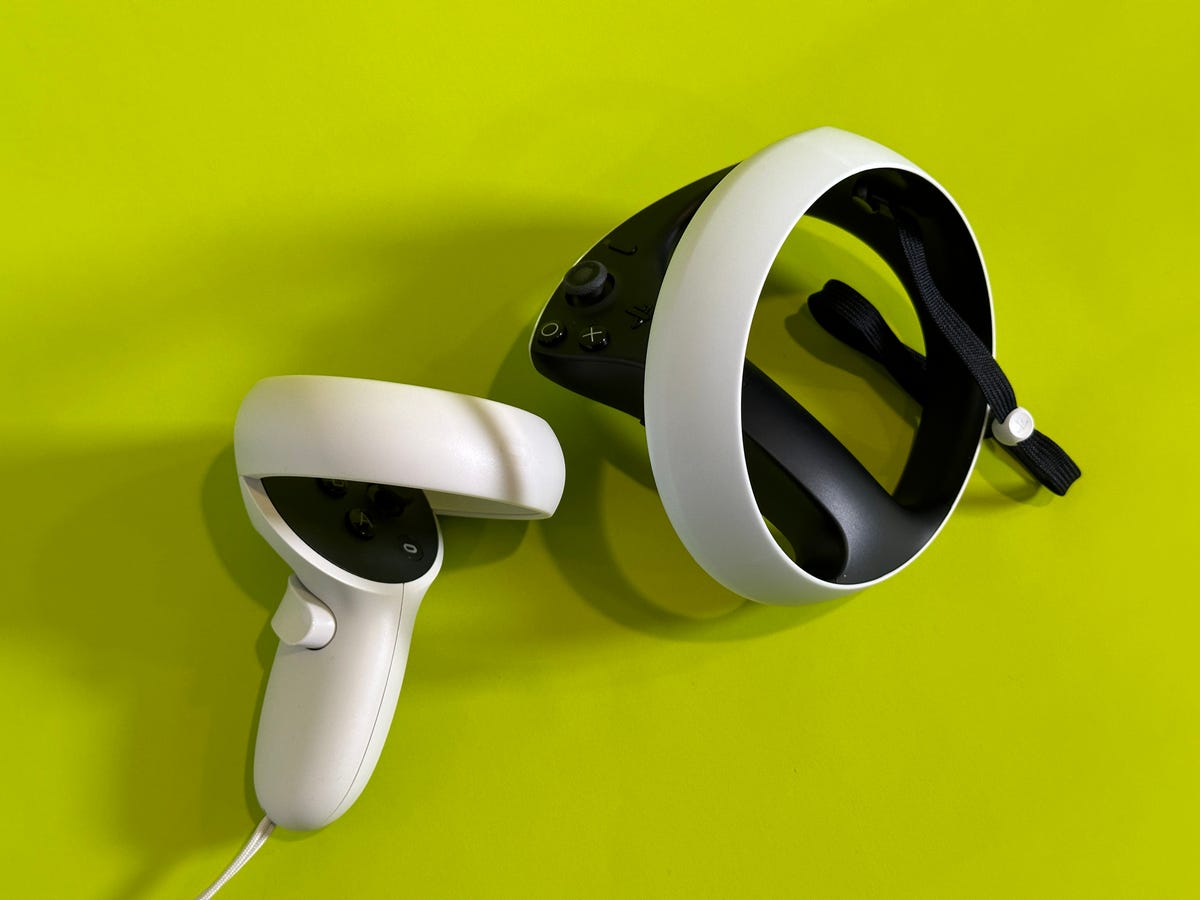
The Quest 2 Touch controller (left) and PSVR 2 Sense controller: Similar button/stick/trigger layout, but the PSVR 2 has better haptics and force feedback, while the Quest 2 has better finger sensing off-button.
Scott Stein/CNETControllers and input: PSVR 2 has better haptics and eye tracking, Quest 2 has hand tracking
The PSVR 2 and Quest 2 have the same type of controller design, mostly: VR headsets have settled on buttons, analog sticks, triggers and grips that are pretty consistent across the board. The PSVR 2 Sense controllers have much better vibration feedback and even force-feedback «adaptive triggers» that offer resistance in some games. These are features the PS5 DualSense controller already has, but they feel a lot richer in VR than the Quest 2’s pretty basic buzzing. The PSVR 2 also uses eye tracking to add additional controls in some games, letting you glance at objects to select them, potentially improving accuracy.
The Quest 2 has better finger awareness when holding the controllers, sensing when your fingers are on or off, or even resting on the buttons or triggers. This awareness can create sensations that feel like hand tracking. The PSVR 2 doesn’t do this nearly as well yet. Also, the Quest 2 can do actual hand tracking without needing any controllers. This input type isn’t perfect, but it can be helpful… and the PSVR 2 doesn’t do this at all (yet).
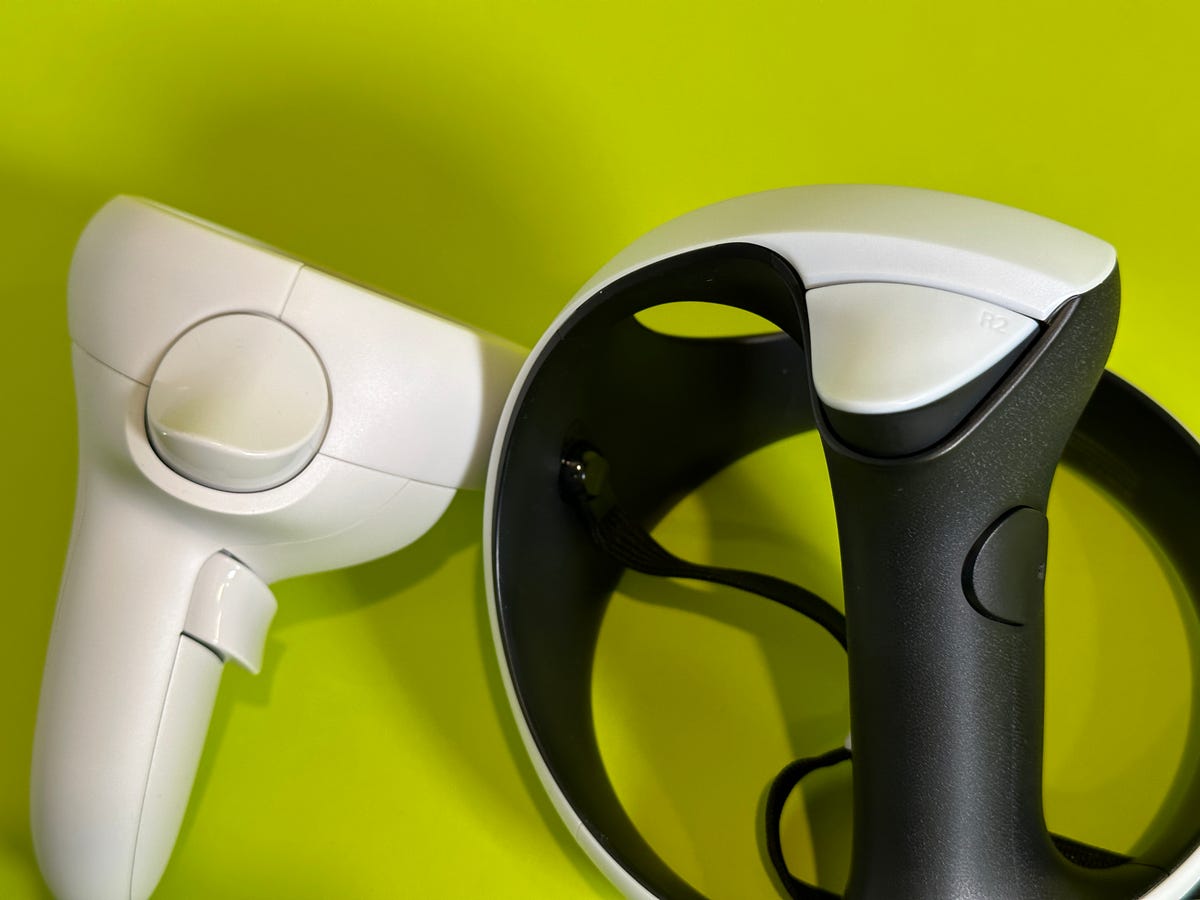
The PSVR 2’s triggers (right) have pressurized force feedback you can feel, which gives an edge for some games.
Scott Stein/CNETSoftware: Quest 2 has a huge advantage (for now), PSVR 2 has some standouts
The Quest 2’s software library covers hundreds of games, productivity and design apps, fitness apps, meditation apps and social world apps. There are also plenty of free apps and games. The Quest platform has been around since 2019, giving it a big lead time. The PSVR 2 is starting from scratch. The hardware isn’t automatically backward-compatible with original PSVR games. Although many of those games are getting PSVR 2 upgrades, it means waiting for the updates to happen, if they do at all.
For now, the PSVR 2 is also skipping entire genres found on the Quest 2. The PSVR 2 is all games, as you’d expect. There should be a few fitness apps (Les Mills Body Combat is already available) but no social world apps. That might be comforting for parents with younger kids, but it leaves out extra uses you could get from the still-evolving Quest 2.
Additionally, most of the PSVR 2 launch games are ports of games on the Quest 2. Only a few are unique standouts that the Quest 2 natively lacks: notably Horizon Call of the Mountain, Gran Turismo 7, Resident Evil Village and No Man’s Sky, with more coming.
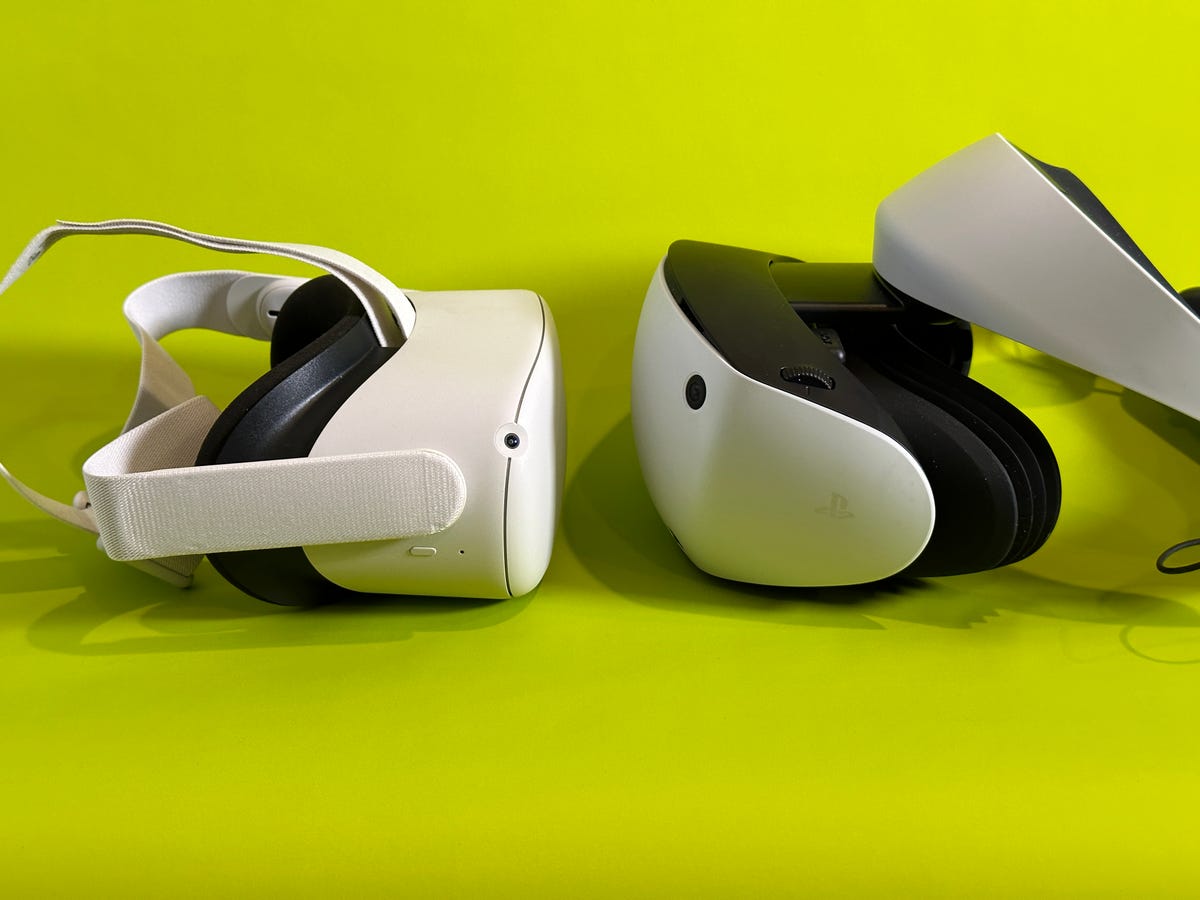
The PSVR 2 (right) has eye tracking and more adjustable eye distance, or IPD, while the Quest 2 lacks eye tracking and has only three IPD settings.
Scott Stein/CNETPrice: Quest 2 has the edge
The $399 all-in value of the Quest 2 is a big advantage here. The PSVR 2 is more expensive at $550, and you still need the PS5, making it a $1,000-plus investment. But the Quest 2 is getting old, and a Quest 3 will likely come later this year that you should hold off for.

Yes, you should wait
Now is the time to wait and see what comes for VR. The Quest 3, expected by the end of the year, should be a clear upgrade over the nearly three-year-old Quest 2, and there’s a chance that many more games (and even a holiday bundle) will upgrade the PSVR 2 experience by year’s end. If you can, I’d hang on and see what the situation looks like for both Meta and Sony in the fall.
If you already have a Quest 2, the PSVR 2 doesn’t offer enough yet to make the switch. And if you’re a PS5 owner who doesn’t mind spending a bunch of money on new tech, the PSVR 2 is already a fun experience, just one we can’t quite get a future sense of yet.
Technologies
Today’s NYT Strands Hints, Answers and Help for Nov. 28 #635
Here are hints and answers for the NYT Strands puzzle for Nov. 28, No. 635.
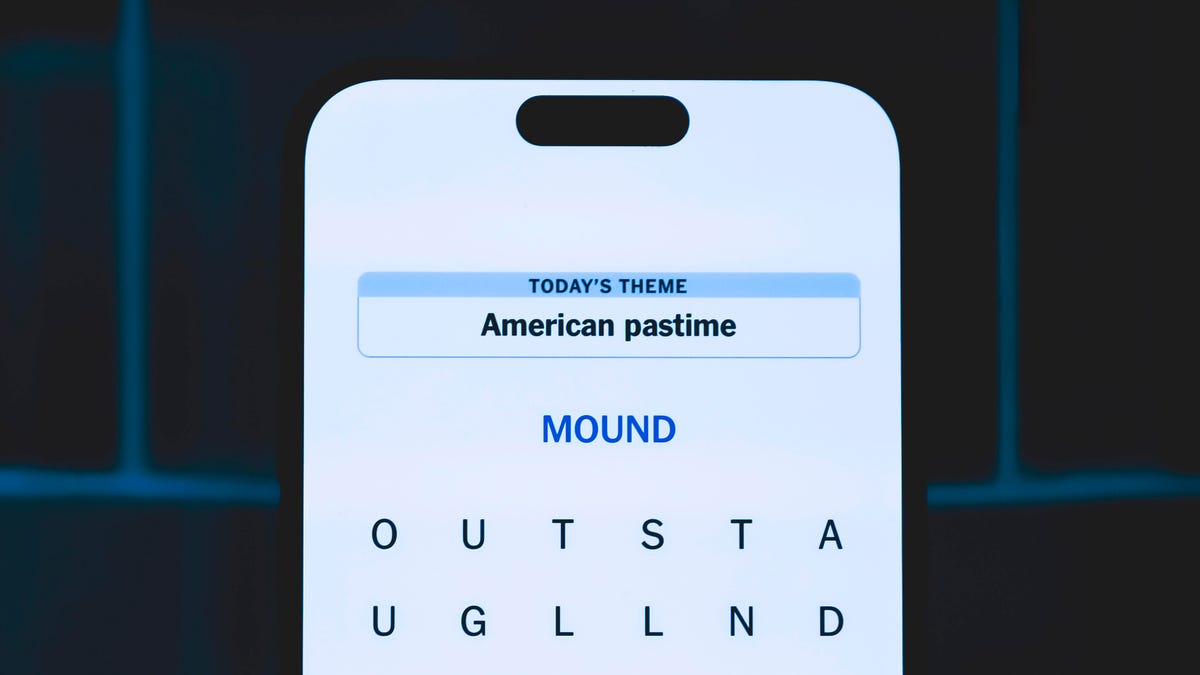
Looking for the most recent Strands answer? Click here for our daily Strands hints, as well as our daily answers and hints for The New York Times Mini Crossword, Wordle, Connections and Connections: Sports Edition puzzles.
Today’s NYT Strands puzzle is pretty tricky. If you’re not familiar with certain superstitious beliefs, you might not find all the answers. And some of the answers are difficult to unscramble, so if you need hints and answers, read on.
I go into depth about the rules for Strands in this story.
If you’re looking for today’s Wordle, Connections and Mini Crossword answers, you can visit CNET’s NYT puzzle hints page.
Read more: NYT Connections Turns 1: These Are the 5 Toughest Puzzles So Far
Hint for today’s Strands puzzle
Today’s Strands theme is: If all else fails…
If that doesn’t help you, here’s a clue: Don’t tell, it won’t come true.
Clue words to unlock in-game hints
Your goal is to find hidden words that fit the puzzle’s theme. If you’re stuck, find any words you can. Every time you find three words of four letters or more, Strands will reveal one of the theme words. These are the words I used to get those hints but any words of four or more letters that you find will work:
- GLUB, RATS, TARN, DALE, FONT, FOUNT, LASH
Answers for today’s Strands puzzle
These are the answers that tie into the theme. The goal of the puzzle is to find them all, including the spangram, a theme word that reaches from one side of the puzzle to the other. When you have all of them (I originally thought there were always eight but learned that the number can vary), every letter on the board will be used. Here are the nonspangram answers:
- DANDELION, STAR, COIN, FOUNTAIN, LADYBUG, EYELASH
Today’s Strands spangram
Today’s Strands spangram is MAKEAWISH. To find it, start with the M that’s three letters down on the far right, and wind backwards.
Technologies
Today’s NYT Connections Hints, Answers and Help for Nov. 28, #901
Here are some hints and the answers for the NYT Connections puzzle for Nov. 28, #901.

Looking for the most recent Connections answers? Click here for today’s Connections hints, as well as our daily answers and hints for The New York Times Mini Crossword, Wordle, Connections: Sports Edition and Strands puzzles.
Today’s NYT Connections puzzle is kind of tough. If you need help sorting the answers into groups, you’re in the right place. Read on for clues and today’s Connections answers.
The Times now has a Connections Bot, like the one for Wordle. Go there after you play to receive a numeric score and to have the program analyze your answers. Players who are registered with the Times Games section can now nerd out by following their progress, including the number of puzzles completed, win rate, number of times they nabbed a perfect score and their win streak.
Read more: Hints, Tips and Strategies to Help You Win at NYT Connections Every Time
Hints for today’s Connections groups
Here are four hints for the groupings in today’s Connections puzzle, ranked from the easiest yellow group to the tough (and sometimes bizarre) purple group.
Yellow group hint: Appropriate.
Green group hint: I win!
Blue group hint: Musical instrument.
Purple group hint: Time to talk.
Answers for today’s Connections groups
Yellow group: Fitting.
Green group: Achieve victory over.
Blue group: Parts of an electric guitar.
Purple group: Phonetic elements of speech.
Read more: Wordle Cheat Sheet: Here Are the Most Popular Letters Used in English Words
What are today’s Connections answers?
The yellow words in today’s Connections
The theme is fitting. The four answers are fair, just, proper and right.
The green words in today’s Connections
The theme is achieve victory over. The four answers are beat, best, take and worst.
The blue words in today’s Connections
The theme is parts of an electric guitar. The four answers are fret, peg, pickup and string.
The purple words in today’s Connections
The theme is phonetic elements of speech. The four answers are intonation, loudness, rhythm and stress.
Technologies
Anker’s New MagSafe Car Mount Keeps Your Phone Cool While Charging, and It’s 30% Off for Black Friday
Get wired-like charging speeds and MagSafe compatibility with Anker’s wireless car charging bundle for $62.99.
Black Friday is the best time of the year to upgrade the little essentials that make your everyday tech life more pleasant. I’ve found the perfect deal to amp up the phone charging setup in your car. This Anker MagSafe wireless car charging bundle is 30% off for the holidays, and it gives your iPhone a fast and steady way to power up while you navigate. It delivers up to 25-watt wireless charging speeds and with onboard active cooling, your phone stays comfortable to the touch.
Get it now for $62.99 verses the list price of $89.99.
What sets this charger apart is that its performance and cooling tech is built into a surprisingly compact package. The stand uses an ultra-strong Qi2 magnetic lock to keep your phone secure through bumps and turns. You can even tilt the mount and switch between portrait and landscape modes for navigation without blocking the view. The bundle has everything you need to get started including a 60-watt dual-USB-C charger, an adequately long USB-C cable, and cable organizers for a clean setup. Anker also includes a two-year warranty for peace of mind.
If you are getting your car prepped up for driving to a holiday vacation or just need a faster charging mount for your daily commute, this deal makes a lot of sense. CNET’s experts are also tracking more Black Friday and Cyber Monday picks across Apple products, headphones, and more, so you can score more savings before the sales season wraps up.
MOBILE DEALS OF THE WEEK
-
$749 (save $250)
-
$475 (save $175)
-
$499 (save $300)
-
$900 (save $400)
Why this deal matters
A high quality charger is a great addition to any car to speedily top up your phone on the go. You will especially want to look out for options from a top-tier brand like Anker for its fast charging speeds and reliability. This Black Friday deal is an excellent opportunity to save big on a staple car accessory. With holiday shopping heating up and tech accessories being one of the most popular categories, we expect the deal to sell out quick. So don’t wait too long before jumping on it.
Don’t miss any of our unbiased tech content and lab-based reviews. Add CNET as a preferred Google source.
Join Our Daily Deals Text Group!
Get hand-picked deals from CNET shopping experts straight to your phone.
By signing up, you confirm you are 16+ and agree to receive recurring marketing messages at the phone number provided. Consent is not a condition of purchase. Reply STOP to unsubscribe. Msg & data rates may apply. View our Privacy Policy and Terms of Use.
-

 Technologies3 года ago
Technologies3 года agoTech Companies Need to Be Held Accountable for Security, Experts Say
-

 Technologies3 года ago
Technologies3 года agoBest Handheld Game Console in 2023
-

 Technologies3 года ago
Technologies3 года agoTighten Up Your VR Game With the Best Head Straps for Quest 2
-

 Technologies4 года ago
Technologies4 года agoBlack Friday 2021: The best deals on TVs, headphones, kitchenware, and more
-

 Technologies4 года ago
Technologies4 года agoVerum, Wickr and Threema: next generation secured messengers
-

 Technologies4 года ago
Technologies4 года agoGoogle to require vaccinations as Silicon Valley rethinks return-to-office policies
-

 Technologies4 года ago
Technologies4 года agoOlivia Harlan Dekker for Verum Messenger
-

 Technologies4 года ago
Technologies4 года agoiPhone 13 event: How to watch Apple’s big announcement tomorrow


